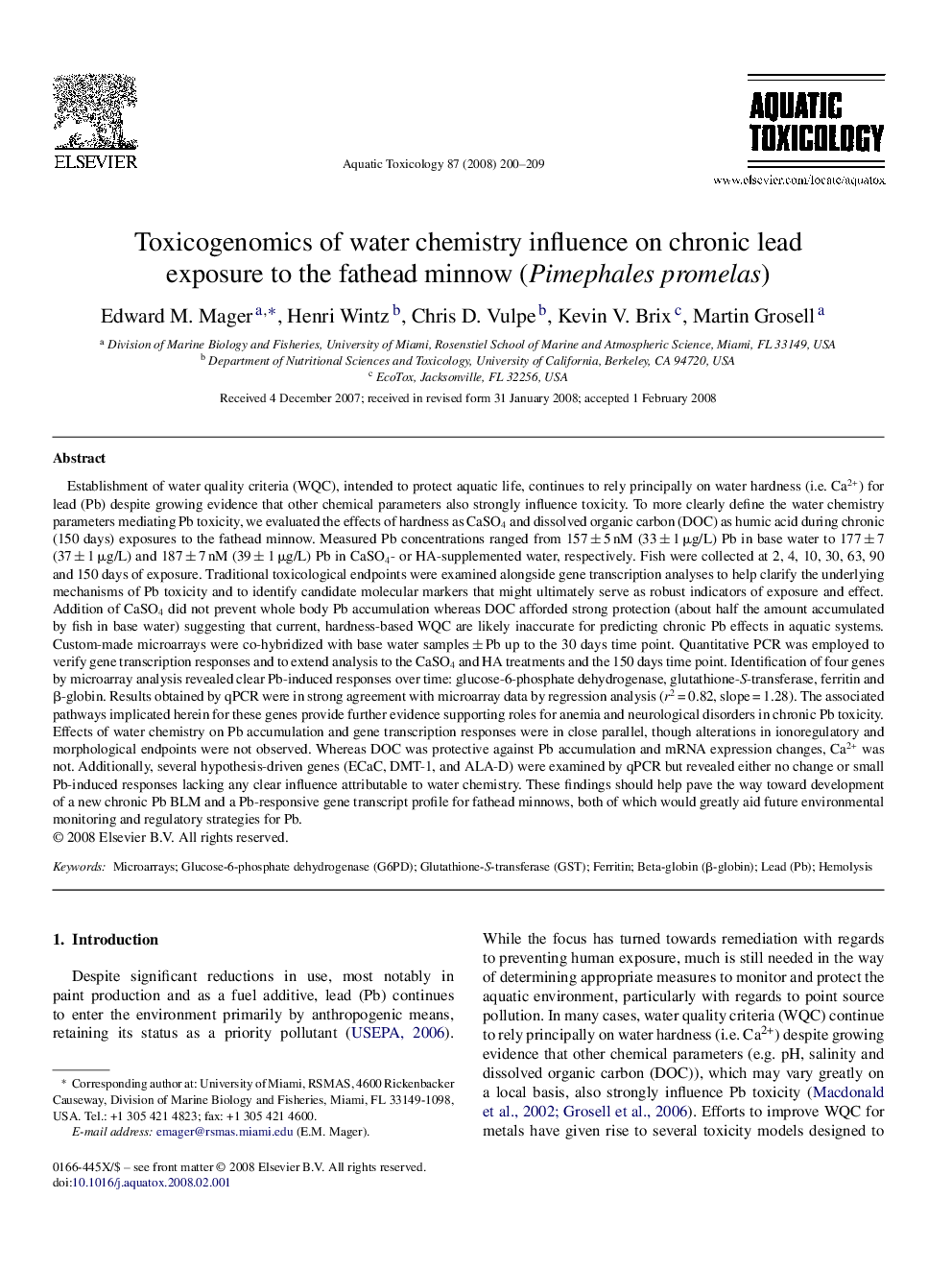| کد مقاله | کد نشریه | سال انتشار | مقاله انگلیسی | نسخه تمام متن |
|---|---|---|---|---|
| 4531011 | 1324746 | 2008 | 10 صفحه PDF | دانلود رایگان |
عنوان انگلیسی مقاله ISI
Toxicogenomics of water chemistry influence on chronic lead exposure to the fathead minnow (Pimephales promelas)
دانلود مقاله + سفارش ترجمه
دانلود مقاله ISI انگلیسی
رایگان برای ایرانیان
کلمات کلیدی
موضوعات مرتبط
علوم زیستی و بیوفناوری
علوم کشاورزی و بیولوژیک
علوم آبزیان
پیش نمایش صفحه اول مقاله

چکیده انگلیسی
Establishment of water quality criteria (WQC), intended to protect aquatic life, continues to rely principally on water hardness (i.e. Ca2+) for lead (Pb) despite growing evidence that other chemical parameters also strongly influence toxicity. To more clearly define the water chemistry parameters mediating Pb toxicity, we evaluated the effects of hardness as CaSO4 and dissolved organic carbon (DOC) as humic acid during chronic (150 days) exposures to the fathead minnow. Measured Pb concentrations ranged from 157 ± 5 nM (33 ± 1 μg/L) Pb in base water to 177 ± 7 (37 ± 1 μg/L) and 187 ± 7 nM (39 ± 1 μg/L) Pb in CaSO4- or HA-supplemented water, respectively. Fish were collected at 2, 4, 10, 30, 63, 90 and 150 days of exposure. Traditional toxicological endpoints were examined alongside gene transcription analyses to help clarify the underlying mechanisms of Pb toxicity and to identify candidate molecular markers that might ultimately serve as robust indicators of exposure and effect. Addition of CaSO4 did not prevent whole body Pb accumulation whereas DOC afforded strong protection (about half the amount accumulated by fish in base water) suggesting that current, hardness-based WQC are likely inaccurate for predicting chronic Pb effects in aquatic systems. Custom-made microarrays were co-hybridized with base water samples ± Pb up to the 30 days time point. Quantitative PCR was employed to verify gene transcription responses and to extend analysis to the CaSO4 and HA treatments and the 150 days time point. Identification of four genes by microarray analysis revealed clear Pb-induced responses over time: glucose-6-phosphate dehydrogenase, glutathione-S-transferase, ferritin and β-globin. Results obtained by qPCR were in strong agreement with microarray data by regression analysis (r2 = 0.82, slope = 1.28). The associated pathways implicated herein for these genes provide further evidence supporting roles for anemia and neurological disorders in chronic Pb toxicity. Effects of water chemistry on Pb accumulation and gene transcription responses were in close parallel, though alterations in ionoregulatory and morphological endpoints were not observed. Whereas DOC was protective against Pb accumulation and mRNA expression changes, Ca2+ was not. Additionally, several hypothesis-driven genes (ECaC, DMT-1, and ALA-D) were examined by qPCR but revealed either no change or small Pb-induced responses lacking any clear influence attributable to water chemistry. These findings should help pave the way toward development of a new chronic Pb BLM and a Pb-responsive gene transcript profile for fathead minnows, both of which would greatly aid future environmental monitoring and regulatory strategies for Pb.
ناشر
Database: Elsevier - ScienceDirect (ساینس دایرکت)
Journal: Aquatic Toxicology - Volume 87, Issue 3, 1 May 2008, Pages 200-209
Journal: Aquatic Toxicology - Volume 87, Issue 3, 1 May 2008, Pages 200-209
نویسندگان
Edward M. Mager, Henri Wintz, Chris D. Vulpe, Kevin V. Brix, Martin Grosell,